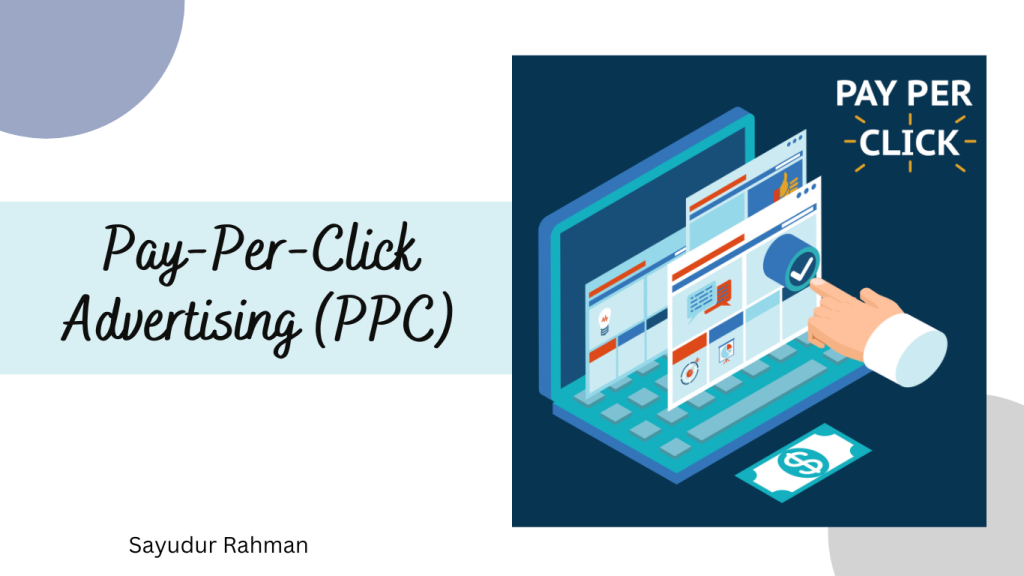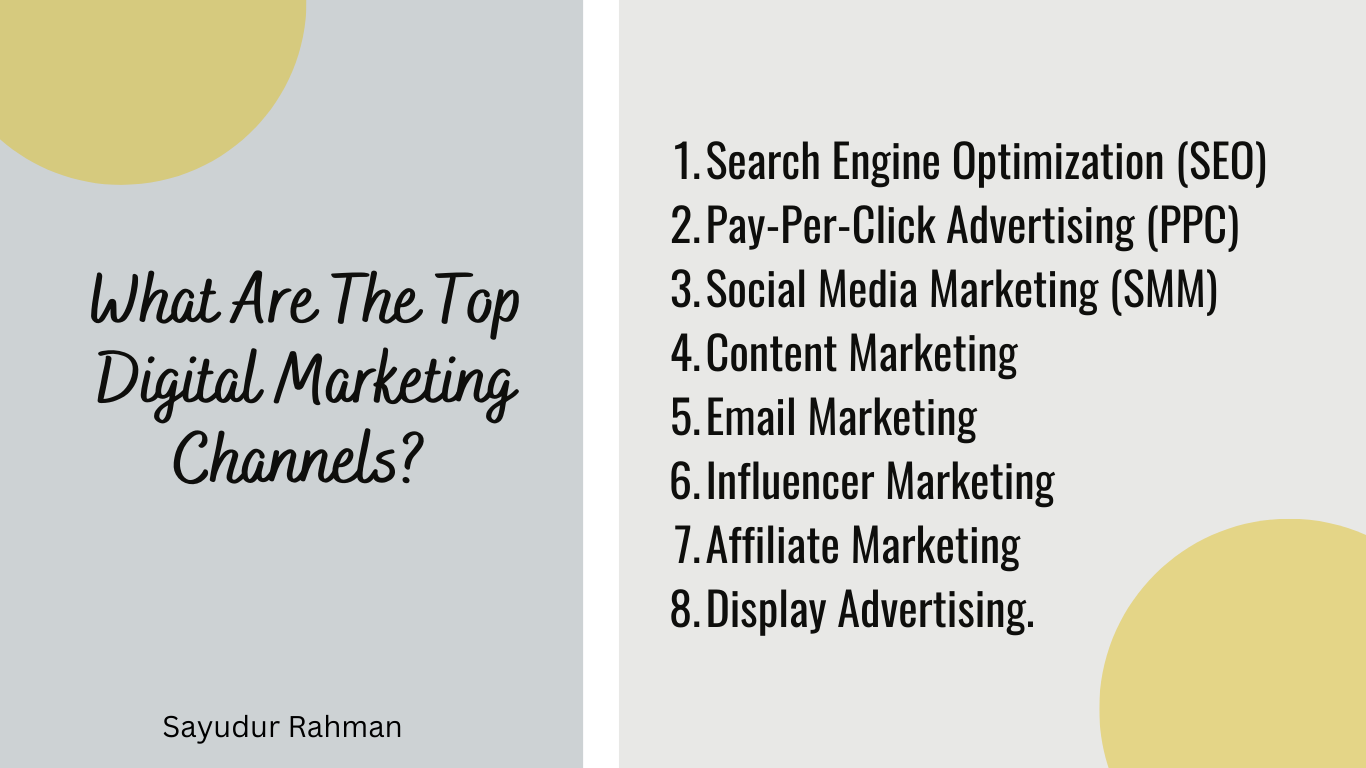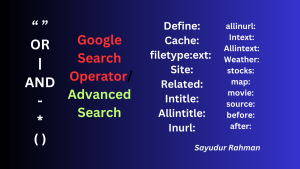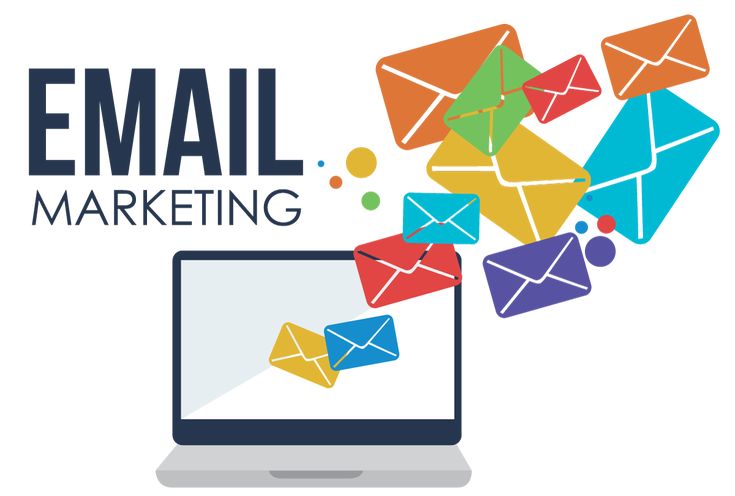What Are The Top Digital Marketing Channels?
- Search Engine Optimization (SEO)
- Pay-Per-Click Advertising (PPC)
- Social Media Marketing (SMM)
- Content Marketing
- Email Marketing
- Influencer Marketing
- Affiliate Marketing
- Display Advertising.
What is a Digital Marketing Channel?
Digital marketing channels are the ways businesses reach and engage with customers through various digital channels, such as websites, social media, search engines, and mobile devices. These channels allow companies to communicate with their target audience, build brand awareness, and drive sales and conversions. Some common digital marketing channels include search engine optimization, pay-per-click advertising, social media marketing, content marketing, email marketing, influencer marketing, and display advertising.
1.Search Engine Optimization (SEO):

Search Engine Optimization (SEO) is the process of optimizing a website in order to improve its ranking and visibility in search engine results pages (SERP) for specific keywords or phrases. SEO involves optimizing both on-page (content and structure of the website) and off-page (backlinks from other websites) factors, in order to make a website more attractive to search engines and provide relevant and valuable content to users. The goal of SEO is to increase organic traffic and visibility of a website, which can lead to more leads and sales.
2.Pay-Per-Click Advertising (PPC):

Pay-Per-Click Advertising (PPC) is a form of digital advertising where advertisers pay each time a user clicks on one of their ads. Advertisers create ad campaigns and bid on keywords related to their products or services, and their ads are displayed on search engine results pages (SERPs) or other websites that partner with the advertising platform. The most popular PPC platform is Google Ads, but there are others such as Bing Ads, Yahoo Gemini, and Facebook Ads. PPC is a quick way for businesses to reach a large audience and drive traffic to their website, but it can be expensive if not managed properly, as the cost per click can add up quickly.
3.Social Media Marketing (SMM):
Social Media Marketing (SMM) is the process of promoting a product, service, or brand through social media platforms, such as Facebook, Instagram, Twitter, LinkedIn, and others. It involves creating and sharing engaging content, such as posts, images, videos, and infographics, with the goal of increasing brand awareness and driving traffic to a website. SMM also includes paid advertising on social media, where businesses can target specific demographics, locations, and interests. The aim of SMM is to build relationships with potential and current customers, and to ultimately drive sales and conversions.
4.Content Marketing:
Content Marketing is a strategic approach to creating and distributing valuable, relevant, and consistent content to attract and retain a target audience and ultimately drive profitable customer action. The goal of content marketing is not to directly sell, but to educate, inform, and build trust with the audience, so they are more likely to purchase a product or service in the future. Types of content used in content marketing include blog posts, videos, podcasts, infographics, and more. The success of content marketing is measured by its ability to drive engagement, lead generation, and customer loyalty.
5.Email Marketing:
Email Marketing is a direct digital marketing channel that involves sending promotional, transactional, or informational messages to a list of subscribers via email. It is used to build relationships with customers, promote products or services, and drive sales. Email marketing campaigns can include newsletters, promotional offers, event invitations, and more. The goal of email marketing is to reach the right people, at the right time, with the right message. The success of email marketing is measured by metrics such as open rates, click-through rates, and conversions. Effective email marketing requires a well-defined target audience, a clear call-to-action, and high-quality content that resonates with subscribers.
6.Influencer Marketing:
Influencer Marketing is a form of marketing where a brand partners with individuals who have a large following on social media platforms, such as Instagram, TikTok, or YouTube, to promote its products or services. The idea behind influencer marketing is that these individuals have a loyal and engaged following who trusts their opinions and recommendations, making them powerful advocates for a brand. Influencer marketing can take the form of sponsored posts, product reviews, or collaborations. The success of influencer marketing is measured by metrics such as reach, engagement, and conversions, and it can be an effective way for a brand to tap into a new audience and reach its target market in a unique and authentic way.
7.Affiliate Marketing:

Affiliate Marketing is a performance-based marketing strategy where a business pays affiliates for driving traffic, sales, or leads. Affiliates promote the business’s products or services through unique links, banners, or ads on their websites, social media accounts, or other channels. When a customer clicks on the affiliate’s link and makes a purchase, the affiliate earns a commission. Affiliate marketing allows businesses to reach a wider audience, increase brand awareness, and drive sales, while giving affiliates the opportunity to earn money by promoting products they believe in. The success of affiliate marketing is measured by the number of conversions and sales generated, and it can be an effective way for businesses to increase their online presence and revenue.
8.Display Advertising:
Display Advertising is a form of online advertising that involves placing banner ads, rich media, and other types of advertisements on websites and mobile apps. The ads can appear in a variety of sizes and formats and are designed to catch the user’s attention and drive engagement. Display advertising can be done through various networks, such as Google Display Network, and can be targeted to specific demographics, locations, and interests. Display advertising is often used in conjunction with other digital marketing channels, such as search engine marketing and social media marketing, to increase brand awareness and drive conversions. The success of display advertising is measured by metrics such as impressions, clicks, and conversions.
In conclusion, digital marketing has become an essential tool for businesses to reach and engage their target audience. With the rise of the internet and digital technologies, digital marketing has expanded to encompass a wide range of channels, each with its own unique strengths and benefits. The top digital marketing channels include Search Engine Optimization (SEO), Pay-Per-Click Advertising (PPC), Social Media Marketing (SMM), Content Marketing, Email Marketing, Influencer Marketing, Affiliate Marketing, and Display Advertising.
Search Engine Optimization (SEO) helps businesses improve their visibility in search engine results pages (SERPs), leading to increased organic traffic and higher brand awareness. Pay-Per-Click Advertising (PPC) allows businesses to reach a large and highly-targeted audience quickly, making it a valuable tool for driving traffic, leads, and sales. Social Media Marketing (SMM) provides businesses with a platform to engage with their target audience, build brand awareness, and drive conversions.
Content Marketing helps businesses educate and inform their target audience, establish themselves as thought leaders in their industry, and drive long-term engagement and loyalty. Email Marketing allows businesses to build personal relationships with their target audience and drive sales by delivering targeted and relevant messages directly to their inbox. Influencer Marketing provides businesses with the opportunity to reach a large and engaged audience through trusted and influential individuals, increasing brand awareness and driving conversions.
Affiliate Marketing provides businesses with a way to reach new audiences and drive sales by partnering with other websites and individuals. Display Advertising provides businesses with a way to reach a large and targeted audience through visually appealing and attention-grabbing ads. Each channel has its own strengths and weaknesses, and the most effective digital marketing strategy will depend on a business’s goals, target audience, and budget.
In summary, digital marketing channels play a crucial role in the success of a comprehensive digital marketing strategy. By using a combination of digital marketing channels, businesses can reach their target audience, increase brand awareness, and drive conversions. The most effective digital marketing strategy will depend on a business’s goals, target audience, and budget, but by utilizing a variety of digital marketing channels, businesses can maximize their online presence and reach their marketing objectives.









